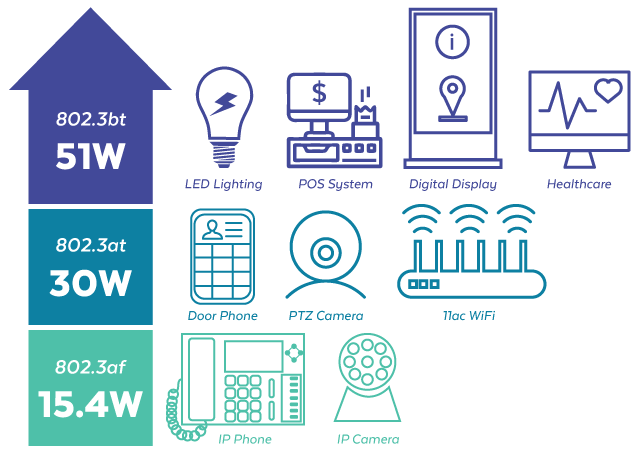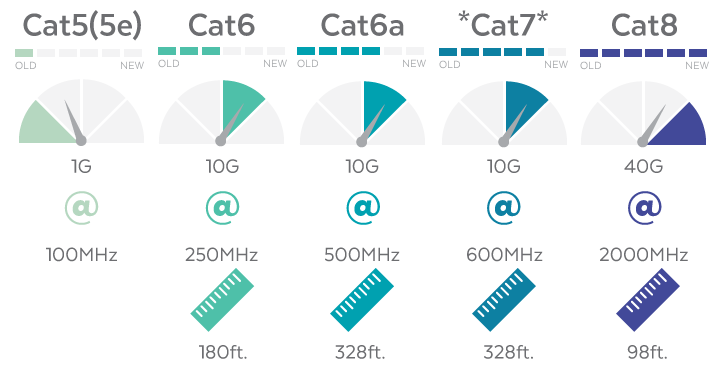In early 2024, the Ethernet Alliance conducted a survey to assess the overall health and spread of the Power over Ethernet (PoE) market. The results showed that 33% of the respondents planned to install PoE devices with power greater than 51W within the coming year. For many companies, adding more powerful devices to their IT network meant a PoE network upgrade.
What Does a PoE Network Upgrade Mean?
PoE is a technology that transmits power and data over a single Ethernet cable. Network-attached PoE devices, therefore, do not require a separate power source. The Institute of Electronics and Electrical Engineering (IEEE) maintains the standards that ensure interoperability among PoE-capable devices. The first PoE standard (IEEE 802.3af) was issued in 2003 for devices requiring less than 15.4W of power.
In 2009, the PoE+ standard (IEEE 802.3at) increased the power output to 30W. These standards supported Type 1 and Type 2 devices such as PTZ surveillance cameras and door phones. In 2018, the IEEE issued its 802.3bt standard, which supports Type 3 and 4 devices that demand power over 51W, such as LED lighting, POS systems, digital displays and healthcare.

More Powerful Devices
The Internet of Things (IoT) trend created a landscape that placed powered devices at the network edge. Whether it’s more sensors for better climate control or AI-assisted surveillance for improved security, PoE-capable devices eliminate the need for separate power sources, especially in remote locations. Imagine an array of PoE sensors connected to a lighting control system. When these sensors indicate an empty room, the software can instruct the PoE-powered LED lighting system to turn off the lights. All without any manual intervention.
Faster Transmission Speeds
Data transmission speeds in a PoE-enabled network will largely depend on the type of Ethernet cable used. For many years, Category 5 Ethernet cables were standard in most computer networks. Some organizations moved to an enhanced category 5 (5e) cable to allow for 100MHz bandwidth and data rates up to 1 Gbps. Network administrators should use Cat 5 and 5e cables with PoE devices relying on the IEEE 802.3af and 802.3at standards.
Today’s demand for faster data transfer has pushed manufacturers to deliver category 6, 6a, and 8 Ethernet cables.
- Cat 6. 250MHz provides up to 10 Gbps over short distances (180 feet).
- Cat 6a. 500 MHz provides up to 10 Gbps over longer distances (328 feet).
- Cat 8. 2000 MHz provides up to 40 Gbps with a max distance of 98 feet.
Category 7 cables provide 600 MHz of bandwidth and up to 10 Gbps. It’s worth noting that the Cat 7 cable is not widely used and has limited availability. Most systems requiring something more powerful than a Cat6a will use the Cat8.

Less Power Consumption
PoE power sources send low-voltage pulses to connected devices. If the device responds as expected, the connection is established, and power flows to the device. If the PoE device’s power requirements change, the technology uses the same notification sequence to inform the power source.
When a powered device is not in use, it sends pulses to the power source to indicate it is still connected. The latest IEEE 802.3bt standard reduces the time required to draw power. When first created, PoE devices drew power 20% of the time. Today, these devices draw power less than 2% of the time. This reduction in power consumption lowers the cost of operating LED lights and motion detectors when not in continuous use.
Planning a PoE Network Upgrade
Performing a network upgrade involves evaluating the network, identifying components that need upgrades, and establishing a budget. However, upgrading a PoE network in today’s competitive market requires more than a basic installation plan. Organizations considering upgrading their PoE network should consider taking the following additional steps:
Interoperability
When the IEEE released its 802.3at standard in 2009, the business community was already looking for faster data transmission rates. It wasn’t until 2018 that the IEEE published its 802.3bt standard, which enabled PoE manufacturers to develop compliant devices. Before the 802.3bt and without a universal standard to align with, manufacturers devised their own to meet market demand. As a result, businesses may run into compatibility issues when attempting to upgrade.
The Ethernet Alliance has initiated a PoE certification program to assist users in identifying standard-compliant devices. Devices that pass the Alliance’s certification process will carry a certification logo, making it easier for businesses to ensure device interoperability. Assessing network compatibility goes beyond swapping out older technology. It also requires looking at power-sourcing equipment and powered devices regardless of age.

The first step in any upgrade plan should be identifying non-compliant equipment and targeting it for replacement. Using compliant devices makes backward compatibility possible, providing greater implementation flexibility.
Capacity
Upgrading a network revolves around capacity. What is the network’s current capacity? Ensuring the upgrade accounts for growth can minimize the need for another effort next year. Extend the upgrade cycle by checking the following:
- Network Bandwidth: What is the current bandwidth, and what percentage is in use? Increasing bandwidth can avoid unnecessary bottlenecks and slow response times if the network is almost at capacity.
- Cables: If the network uses Cat5 or Cat5e cables, consider upgrading to Cat6. Most construction companies today fit new buildings with Cat6 or Cat6a to meet this new market demand.
- Network Design: How is the network laid out? Are there cable runs that exceed the recommended distance for maximum performance? Will upgrading cables help, or does the network need to be reconfigured?
- Power: Assess the power requirements for each PoE device. Check the power capacity of PoE switches and injectors to ensure the infrastructure supports the power demands. Consider an uninterruptible power supply (UPS) for critical areas to maintain operation during power outages.
Competitive Advantage
Businesses run on digital networks that require a technical infrastructure that can deliver better insights faster than the competition. Solutions that can handle this without drastically increasing costs are needed to maintain profitability. By upgrading a PoE network, organizations can experience faster data transfer rates, reduce power consumption, and deploy more devices for continued growth.
Planet Technology USA’s selection of PoE equipment can help you complete your network upgrade. Whether you are looking for managed or unmanaged switches, injectors, or other PoE solutions, Planet has the expertise to help you find the right solution for your upgrade.
Sources:
https://ethernetalliance.org/blog/2024/02/07/qa-the-state-of-the-power-over-ethernet-market/
